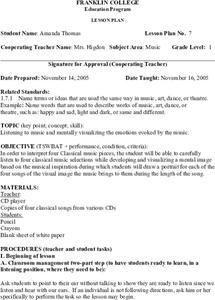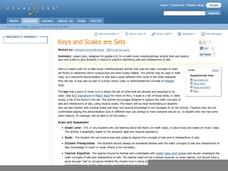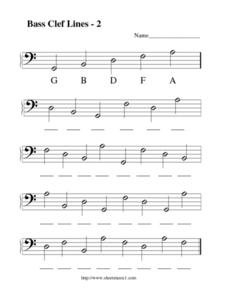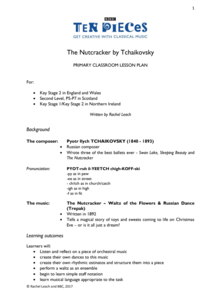Curated OER
Music Terms
Students review and define music terms. In this musical vocabulary lesson, students are given a list of terms, asked to unscramble them, then write the meaning of each term.
Curated OER
Music: Identifying Notes
Fourth graders read the note names in the treble clef staff, including the use of ledger lines above and below the staff. Using Music Ace II, they discover the note names in the treble clef, view examples, and answer questions about...
MakingMusicFun.net
Ready, Set, Go! Note Name Speed Test I - Music Theory Worksheet
In this notes worksheet, students name the notes C through G reading sheet music.
Curated OER
Lesson Exchange: Musical Mathematics (other, Music)
Students explain note values and relationships, especially dotted rhythms and tied notes by giving them a visual, hands on representation
Curated OER
Music and Emotions
First graders examine how certain types of music can evoke emotions and mental images. They fold a piece of paper into four equal sections, and create a picture of what they are visualizing in each section while listening to four...
San Francisco Symphony
Lesson Ideas for Any Music
Music is a wonderful tool you can add to enhance the learning process for every subject. Here is a list of music selections that are categorized by subject, along with some neat teaching suggestions. You'll find songs suited to...
Curated OER
Keys and Scales are Sets
Music theory lessons can be very tricky for some people. Children with a basic understanding of musical concepts take on the task of transposing music and identifying scale sets. This would be a good topic to address prior to discussing...
Curated OER
Timed Note Identification
Before you can play from sheet music, you need to be able to read it. This timed quiz requires the class to identify as many of the 90 notes as they can. Notes are on a staff in both treble and bass clef.
Curated OER
A Pentatonic Scale Activity
The famous Japanese tune, "Cherry Blooms" was composed using a pentatonic scale. Budding musicians explore the nature and theory behind the pentatonic scale as well as the East Asian music it is commonly used in. Multiple extensions are...
Curated OER
Comparing Two Improvisations
Jazz improvisation can be difficult to listen to for some music enthusiasts, however there are patterns and characteristics that can be analyzed. They use this Venn diagram to aid them in comparing two improvisational pieces, where they...
Curated OER
Band On Line
In 1996, using the Internet to enhance learning was a new innovation. While the instructional activity here is a bit outdated, it could still provide a basic understanding of how technology can enhance music appreciation. Members of the...
Curated OER
Lesson: American Idyll
Using the painting, Childhood Idyll for inspiration, learners reflect on things that are idealized. They focus in on pop music and pop idols, write a song, and perform it in front of the class, American Idol style.
Curated OER
Melodic and Harmonic Intervals
If you are teaching music and need a resource to demonstrate melodic and harmonic intervals, you're in luck. This hand out describes and shows what melodic and harmonic intervals look like on a staff.
Curated OER
Treble Clef Lines and Spaces - 3
In this treble clef lines and spaces worksheet, students read the sheet music and identify the letter names of the notes that are missing as they fill in 36 blank spaces.
Curated OER
Bass Clef Lines - 2
For this bass clef lines sheet music worksheet, students read the sheet music and identify the bass clef lines that are missing as they fill in 31 spaces.
Curated OER
Bass Clef Lines - 3
In this bass clef lines sheet music worksheet, students read the sheet music and identify the bass clef lines that are missing as they fill in 30 spaces.
Curated OER
Treble Clef Lines - 2
In this treble clef lines worksheet, students read the sheet music and identify the letter names of the notes that are missing as they fill in 30 blank spaces.
Curated OER
Musical Role Models
Students identify instruments and their sounds and use them to model their own orchestra. After choosing an instrument to investigate further, they research to become familiar with the sound of the instrument, how the sound is created,...
Ceramic Arts Daily
Making Sounds with Clay
Here is a great way to incorporate art, history, and music. Learners will make airduct instruments, such as recorders, flutes, and whistles out of clay. The ceramic instruments can be quite ornate and even used to make music. The...
Trinity University Digital Commons
Romanticism: Past and Present
With its focus on nature, individualism, imagination, and rejection of traditional authority, Romanticism has great appeal to young high schoolers. After examining classic paintings and poems as well as current works, class members...
BBC
The Nutcracker by Tchaikovsky
Over the course of six lessons, scholars try their hand at composing and dancing after a thorough examination of the famous ballet, The Nutcracker, by Tchaikovsky. Participants watch and discuss the performance of two dances, create and...
Smithsonian Institution
The Vocal Blues: Created in the Deep South of the U.S.
Bring the sounds of the deep South vocal blues to the classroom with a Smithsonian Folkways lesson. In preparation, scholars listen to and count the 12 bar blues patterns in several works and identify the I, II, IV, and V chords as well...
PBS
Lesson Plan: Divided Opinions
To gain a more in-depth understanding of the tumultuous 1960s, young historians examine video clips, listen to music, examine images, and interview survivors. Once they have a foundation of information about the period, class members...
Angel Island Immigration Station Foundation
Moving to the Poems of Angel Island
A poem carved on Angel Island's walls is the guiding text of a lesson that challenges scholars to put movement into a written piece of art. After warm up-activities, learners play a game of "Pass the Clap" and "Pass the Line," in which...

























